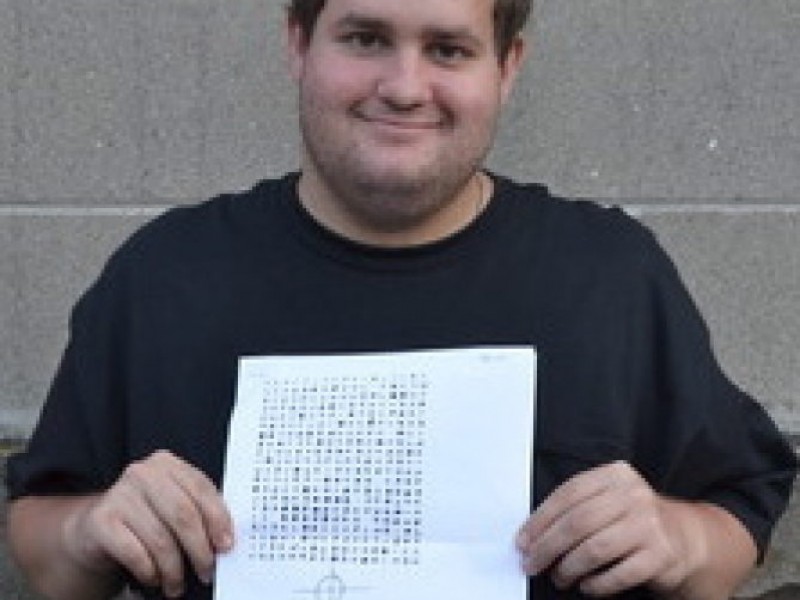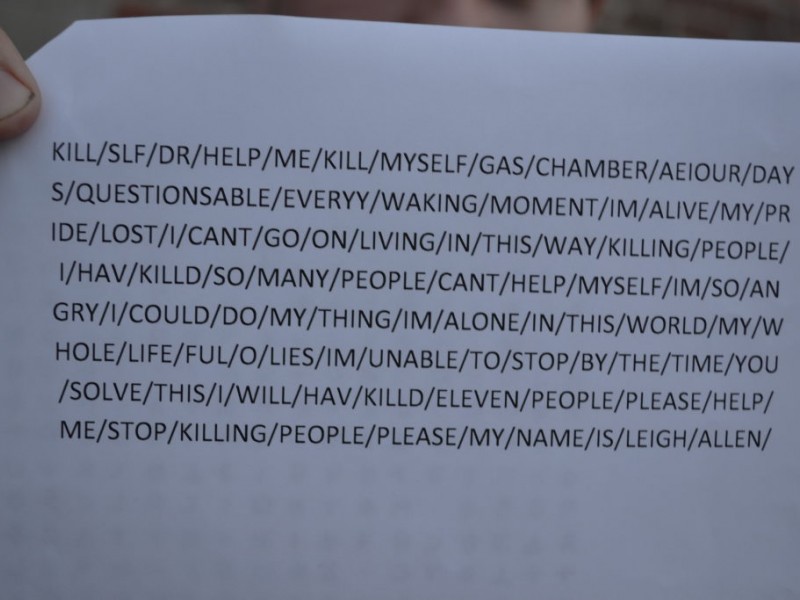
To most, the word "Zodiac" conjures up images of astrological symbols and the positions of stars.
But Corey Starliper, a Tewksbury native and hobby code-cracker, thinks of a serial killer of the same name.
Starliper also thinks that he has solved a cipher devised by Zodiac that has remained unsolved for over 40 years.
Zodiac was the name taken by a murderer who operated in the San Francisco area, including Napa, Solano, and Vallejo counties, in 1968 and 1969. Zodiac sent encrypted communication to area newspapers, taking credit for killings and warning of more to come, according to Robert Graysmith, who personally investigated the murders and wrote several books on the case.
Police attributed seven murders and two attempted murders to Zodiac because of information he was able to provide that was unavailable to the public, though the number of unconfirmed victims may be much higher.
The first coded communication was a three-part cipher sent in portions to the Vallejo Times-Herald, the San Francisco Chronicle, and the San Francisco Examiner on July 31, 1969, according to "Most Evil", written by Steve Hodel. The complete cipher contained 408 characters and was published on August 2 and 3, 1969 in accordance to Zodiac's demands. It took just a few days for the code to be deciphered.
"The first one was cracked by a history teacher and his wife," said Starliper. "What I'm driving at was the first code was cracked by amateurs. So they figure that any communication after that would be able to be cracked by amateurs."
After the decryption of the first code, Zodiac sent many more communications to law enforcement and the media, including his most famous: a 340-character cipher, mailed to the San Francisco Chronicle, according to zodiackillerfacts.com. To this day, the cipher has not been completely cracked.
Starliper, however, believes he has found the solution to that code.
"The first time I saw this code was a couple of years ago, and I knew that it could be cracked," he said. "It was just instinct, I had a gut feeling that it could be cracked. Any code created by man can be cracked by man."
A 2007 movie entitled "Zodiac" was what sparked interest in Starliper about the case.
"I saw the movie first, and when I saw the movie, (I had) instant interest in it," he said, snapping his fingers. "When I read the book, I was ... just hungry for more when the book ended."
Starliper describes the Zodiac serial killer case as "extraordinarily consuming."
"I became absolutely obsessed with the case, to the point that I'd look up from Graysmith's books ... and realize that I'd actually forgotten to eat."
Starliper said that after becoming interested in the code, he abandoned it for some time, but after that, an idea for breaking the code came to him almost by "accident."
According to Robert Graysmith, in "Zodiac", tips received by police after Darlene Ferrin's murder indicated that the killing was connected to the U.S Virgin Islands. Starliper believed that the "340" of the 340 cipher was significant, and had some tie-in with the U.S. Virgin Islands. It was then that he found out that 340 is the area code for a portion of the U.S Virgin Islands — not an insignificant connection.
"So that's what I started with," said Starliper. "I thought, there's no way ... that Zodiac is going to be prosaic enough not to mention the U.S. Virgin Islands in this code. This is where it gets even creepier. 3+4+0=7. Right. So you get 7+0=7. 707...707 are the area codes for Vallejo, Napa, and Solano. So I figured, why not start this with Caesar code using 3,4."
Caesar code is a substitution type cipher where an encoder has "simply replaced each letter in a message with the letter that is three places further down the alphabet," according to http://www.simonsingh.net/The_Black_Chamber/caesar.html.
This doesn't mean the 340 is such an easy task to decode, considering the fact that the original 340 cipher is full of symbols: >, +, and ▲ being just a few of the signs found in the code. To combat this problem, Starliper extracted symbols and changed them to letters they could correspond with. For example, a ^ or < symbol could be interpreted as inverted or sideways "V"s.
"I first went in there and I did that," he said. After everything symbolic had been interpreted alphabetically, he started applying reverse Caesar shifts. He found the first two letters to be "K" and "I".
"What are the next two going to be? right? I figure, what's the first word he's going to throw in there? Kill," said Starliper. "And I was able to keep going from there." For the first few lines, the pattern remained constant, but it changed beyond that. He said he was able to figure out the non-patterned series that by finding "similarities in the numerical sequence."
Starliper split his work into two sessions of 6 hours and 3 hours. When he was done, he had decoded the following text:
KILL/SLF/DR/HELP/ME/KILL/MYSELF/GAS/CHAMBER/AEIOUR/DAYS/QUESTIONSABLE/EVERYY/WAKING/MOMENT/IM/ALIVE/MY/PRIDE/LOST/I/CANT/GO/ON/LIVING/IN/THIS/WAY/KILLING/PEOPLE/I/HAV/KILLD/SO/MANY/PEOPLE/CANT/HELP/MYSELF/IM/SO/ANGRY/I/COULD/DO/MY/THING/IM/ALONE/IN/THIS/WORLD/MY/WHOLE/LIFE/FUL/O/LIES/IM/UNABLE/TO/STOP/BY/THE/TIME/YOU/SOLVE/THIS/I/WILL/HAV/KILLD/ELEVEN/PEOPLE/PLEASE/HELP/ME/STOP/KILLING/PEOPLE/PLEASE/MY/NAME/IS/LEIGH/ALLEN/
Arthur Leigh Allen was a prime suspect during the Zodiac investigation. When Sherwood Morrill, a handwriting expert, examined Allen's writing, he told investigators that the writing was "similar, but not the Zodiac killer's", according to "Zodiac Unmasked" by Robert Graysmith. Allen also passed a polygraph exam during the investigation.
These facts don't bother Starliper.
"Leigh Allen in that situation was forcing his handwriting to look different from the way that he normally wrote," said Starliper, referencing the work of detectives.
Allen died in 1992 at age 58.
The discovery of a solution to the code wasn't "disturbing", as Starliper said he had heard it described, but invigorating.
"To me, I found it exciting, that I was actually able to get into his head when nobody had for over 40 years," said Starliper. "It was a high. One of the best highs I had ever experienced was cracking something that nobody else had cracked in over 40 years."
Starliper didn't let it rest at just solving the code. He tried to get in touch with the counties where the murders originally took place and received little response.
"But Napa, after I sent them the solution to the code, said that they would delve into the case later on in the year. Which to me means, 'you know what kid ... leave me alone.'"
Along with a lack of progress contacting Solano, Vallejo, and Napa counties, Starliper has contacted the San Francisco Cold Case Unit and Special Investigative Unit without response.
"I didn't want it getting lost in the mix. I wanted to contact someone directly," he said. "It's frustrating that ... interest in the case has dropped off, because at one time it was one of San Francisco's highest priorities. It's disheartening to know that the authorities have basically shut the door on it."
He even sent the code to a cryptographer, who, after looking over the solution, said that it appeared "not valid," according to Starliper.
"That really ticked me off," he said. ""With a code that constantly changes a pattern ... you can't attack it using brute force. There are people who have tried. Out of all of the solutions that I've seen this one has the highest readability and probability for accuracy that I've ever come across."
What Starliper hopes to do is to apply his number patterns to the other unsolved ciphers that Zodiac sent to the police.
"What I really mean to do by cracking these codes ... my main goal, is to figure out, for one, exactly who did it, and to bring peace to the families of at least some of Zodiac's suspected victims," he said.

Comments
Post a Comment
Jarring comments...